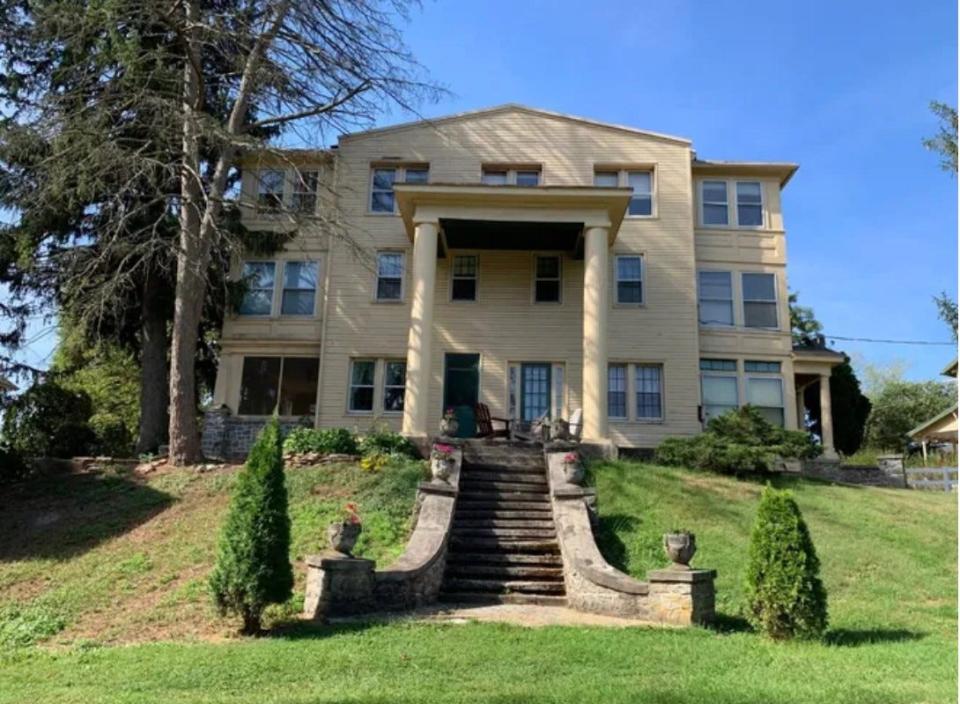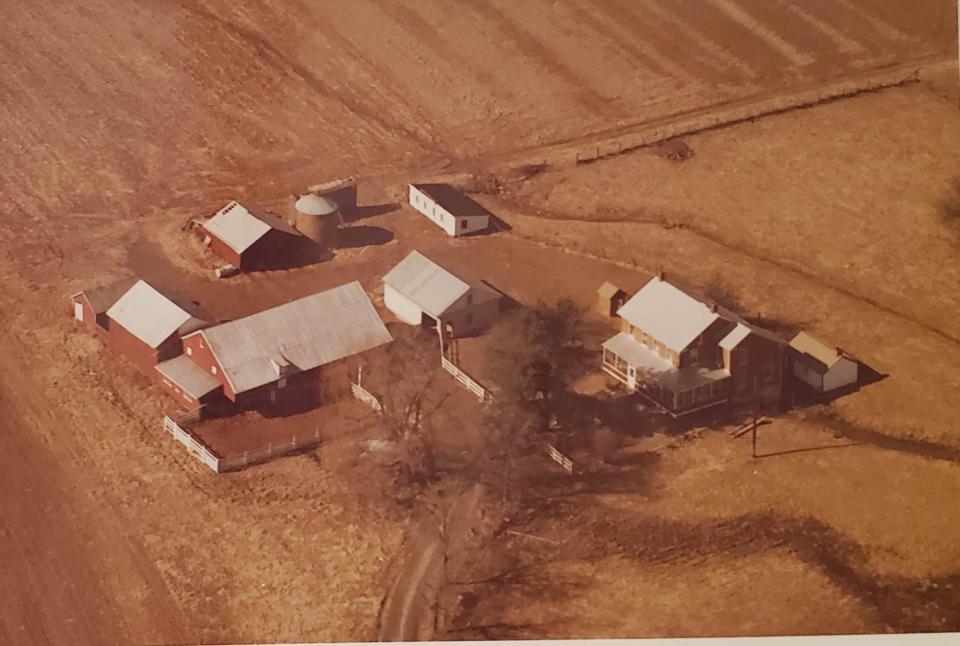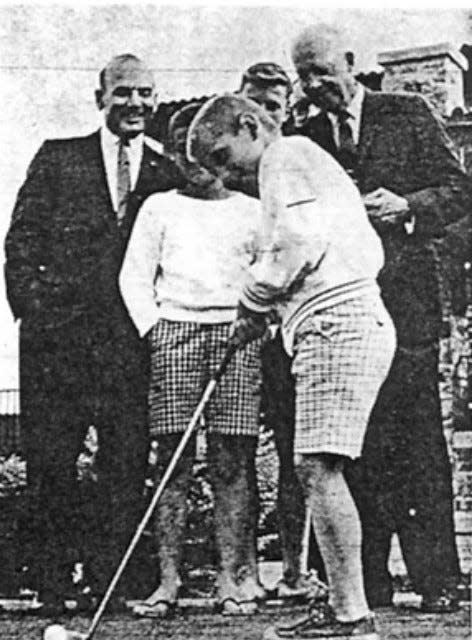Influential Cold War figures called border York/Adams region home
- Oops!Something went wrong.Please try again later.
- Oops!Something went wrong.Please try again later.
- Oops!Something went wrong.Please try again later.
- Oops!Something went wrong.Please try again later.
(Editor’s note: This is another in a series of occasional columns about York County borders and how they helped make York County, York County).
When the world discovered that Joseph Stalin’s daughter had been secreted on a remote farm near Adams County’s East Berlin, a New York Post story carried a telling headline.
“Svetlana,” the headline said about Stalin’s defected daughter, “was Mystery Guest in Quiet Pennsylvania Town.”
“Quiet” is the right description for this border town that rests about the width of Beaver Creek from York County. And it describes why the region that hosts East Berlin borough has attracted four international figures as residents or for frequent visits.
In 1967, the Post reporter drove to the secluded East Berlin-area farmhouse of George Kennan, former ambassador to the Soviet Union and thus known to Svetlana for years. He ran into Kennan’s daughter in the garage of the massive farmhouse as she was getting a lawn mower ready.
“She left this morning,” Joan, Kennan’s daughter, said.
Svetlana stayed in this quiet place for two weeks, went to a beauty shop, plugged coins in an automatic laundry and shopped for groceries. And few would know.
Two quick lessons could be pulled from this story:
If Kennan and three other critical figures in the Cold War loved and appreciated the people and land in western York County, eastern Adams and northern Maryland, that serves as a good example for us. And their presences form another important chapter in local history and could be a lever in teaching and understanding Cold War history, an era that lasted from the post-World War II area to the fall of the Berlin Wall in 1989.

Exploring western York County
Today and in history, some folks in eastern York County tended not to venture west of Interstate 83. And vice versa. For a number of years, some on the east side wondered when they would get a closer Chili’s like the one in Delco. And those on the west side are still looking for their Red Lobster.
Maybe it’s the stop-and-go rigors of driving Route 30, which opened about 1970 to whisk motorists around York city. Or maybe it’s because some in York County’s west end can travel to Baltimore more quickly than Lancaster, much less Philadelphia. That’s been true for centuries and has decidedly tilted York County and its personality toward Baltimore’s gritty Southern style rather than the more urbane City of Brotherly Love.
So it’s time for eastern York countians — and, really, all York County residents — to better understand this green and quiet western region and significant Cold War figures who lived there.
That region is bounded by East Berlin (Kennan) and Westminster, Maryland (anti-Communist writer Whittaker Chambers), about 23 miles, north and south and Menges Mills (Vice-President Richard Nixon) and Gettysburg (President Dwight Eisenhower), east to west, about 20 miles.
And this doesn’t even account for lesser Cold War figures: Hanover’s J.W. Gitt, publisher of The Gazette and Daily in York and Sargent Shriver, John F. Kennedy’s brother-in-law, who helped found the Peace Corps. Shriver was born in Westminster, about 14 miles from York County’s southern border. Another luminary with no previous connection: World War II hero and actor Eddie Albert of TV’s “Green Acres” fame, who was honored twice in East Berlin for his fighting in the Pacific Theater’s Battle of Tawara in 1943.
A place of refuge
The Cold War was a time of tension, the wielding of political and economic and propaganda weapons to ward off deployment of nuclear war.
The four Cold Warriors and others on the front lines of this period clearly knew about the threat of communism and nuclear war. It must have been soul-wrenching as they saw the numbers of ever escalating nuclear arsenals stockpiled by foes and friends.
And they acted on what they saw. American containment strategy was shaped by Kennan in a post-World War II journal article signed “X.” The containment idea held that U.S. and allies should contain or stop the spread of communism in remote places like Vietnam so it doesn’t overwhelm more important strategic countries. With patience, the Soviet Union would collapse on itself, and that’s what happened in the aftermath of the fall of the Berlin Wall.
They sought refuge, choosing the best land to seclude themselves within reasonable distance from Washington, D.C., and other eastern cities.
Most participated in the life of their nearby communities. Eisenhower would come to York to golf. On visits to his family, Nixon would go to stores in Menges Mills and Hanover. Kennan would hang out at a lunch counter and plant trees in East Berlin.
They no doubt enjoyed the live-and-let-live nature of their Pennsylvania Dutch neighbors.
As the New York Post said about the people of East Berlin, who belatedly caught wind of the estranged Stalin family member in their midst: “Almost discreetly, never in ordinary busy-body fashion, groups tried to figure out who the celebrity in town was.”
In 2021, Real Clear History published a piece about Kennan, Eisenhower and Chambers headlined, “These Men Made History, Then Retired to Farms.”
Real Clear did not include Nixon, perhaps understandably because he and his family regularly visited his parents, never establishing residence on their Menges Mills Farm.
So we’ll start with Nixon, who gained enough friends in this area that a county park became his namesake.

Richard Nixon
Frank and Hannah Nixon moved to the Menges Mils farm in 1947 to be near their son, the young congressman just starting his political career.
Richard, wife Pat, and their two children, Julie and Tricia, would visit the farm regularly. The girls would spend summers. And Richard’s brother Edward graduated from West York High School in 1948.
The Nixons moved from Menges Mills in 1954 after Frank fell from a tractor and broke his arm. It didn’t mend well and gave him problems in the winter, impairing his farmwork.
Carl Stambaugh, postmaster and Menges Mills store owner in those years, said in a Sunday Patriot-News interview that Nixon used the store’s phone — the farmhouse did not have one.
“Richard made many calls to Washington during the investigation of (communist) Alger Hiss,” Stambaugh said. “I never made any attention to what he said, but looking back I’m amused because we were a six-family party line.”
Whittaker Chambers
Chambers was an American writer and member of the Communist Party who defected in 1938. The Real Clear History piece said the farm on Maryland’s Pipe Creek served as a refuge to hide from the communists.
Chambers exposed Hiss as a communist, and that led to famous perjury proceedings against the Baltimore-born American government official in the late 1940s.
This land, in private hands today, was home to a moment that fuels the imagination.
As part of the Hiss investigation, Chambers retrieved microfilmed copies of secret State Department documents that Hiss reportedly provided to him to give to the Soviets. He had retrieved them from a hollowed-out pumpkin on his farm.
Nixon was a prime mover against Hiss and launched his political career in the Hiss case and his investigations of other communists.
Dwight Eisenhower
Eisenhower’s Gettysburg farm operates as a national historic site today, the only one of the four that is in public hands.
It preserves those days that Dwight and Mamie Eisenhower first used this farm near the battlefield as a weekend retreat, a place to meet with national and international leaders and eventually their retirement home.
“With its peaceful setting and view of South Mountain, it was a respite from Washington, D.C., and a backdrop for efforts to reduce Cold War tensions,” the farm’s website states.
Eisenhower commanded in World War I and II and, as president, served as commander in chief in the Korean War. And with the Gettysburg battlefield next door, Eisenhower became an authority on the fighting that took place nearby. He would lead tours of the field with Winston Churchill, Charles de Gaulle and others.

George Kennan
York’s Joe Miller of the Miller Lumber Co. purchased Kennan’s future home from George Moul of York. One account said he spared no expense in restoring the home.
After George and Annelise Kennan moved to this land on the bank of the Conewago in 1942, Kennan farmed, hung out in East Berlin and used it as a refuge for writing.
He chose a room closed off from the rest of the house and accessible by a trap door as a getaway to write. His room contained a bookshelf packed with old Soviet journals.
At the time they moved in, a newspaper story said the Kennans were “probably” East Berlin’s most distinguished residents. Well, there was no “probably” about it.
All history is local
Kennan won two Pulitzer Prizes for his work on Russia and his memoirs of his decades of diplomacy.
But he would write and speak about local history, too. He once told an East Berlin group about the Berlin Improvement District, an effort to enhance the town early in the 20th century. The East Berlin Historical Preservation Society has a double-spaced typed manuscript of a speech that Kennan delivered. Its handwritten overstrikes showed that Kennan labored to choose just the right words.
He tells about his adopted region:
After you cross the Susquehanna and travel beyond York, the valley “widens out into a large area of flatland, some 50 miles across bounded on the west and north by the first ridges of the Appalachians and on the south by northern Maryland hills.”
He thus counted the winsome Pidgeon Hills, home of the Nixons, that bisect the western part of York County as the start of rolling Maryland hills, the land of Whittaker Chambers.
But back to the East Berlin area: “This patch of relatively flat territory deserves, if any does, the old-fashioned designation of a ‘fair’ countryside — as fair as anyone could wish.”
East Berlin, he noted, grew in a bend of the Conewago. He might have added that Beaver Creek formed its eastern border, an overlooked waterway that originates south of Abbottstown.
He went on: Some say history is a record of the wars and other “violent follies,” so you might say the East Berlin area is “without history.”
Native American trails did not come near it, as evidenced by a lack of arrowheads.
No modern battle disturbed its peace, although I would observe the distant strife of the Battle of Gettysburg surely terrorized the town.
Three of the four brigades in Gen. Jubal Early’s Confederate infantry division passed through East Berlin on their raid from Gettysburg through York County to the Susquehanna in the days before the Battle of Gettysburg. That totaled about 4,000 veteran fighting men, all practiced at thievery and scavenging, both on the march from and countermarch to Gettysburg.
But Kennan wrote that no old-timers could remember that moment except for a telling story involving the rumor of Early’s approach.
A villager was stationed in a church tower to watch for Confederate troops. After one or two hours, someone yelled up to him: “Jim, do you see anything?”
After scrutiny of fields across the Conewago, Jim replied. “No, but it looks mighty damn suspicious.”
In this reply, Kennan wrote, you had the epitome of the “prudence and circumspection which marks the reaction of the East Berliners (and quite properly so) to many of the phenomena of the passing scene.”
So there it is: Kennan admired his neighbors’ prudence and circumspection — their interest in their famous neighbors but their caution against nosiness and interference.
In the end, this was a compelling factor drawing these four international figures to this quiet region for solitude and to deal with the potential and actual horrors of the Cold War.
Sources: Maryland Historic Trust, YDR files, RealClearHistory.org, East Berlin Historical Preservation Society, MarylandMatters.org, Shawn Carbaugh.
Upcoming presentations
Jim McClure will present about “Presidential Visits to York County,” at the East Berlin Historical Preservation Society at 7:30 p.m. Sept. 20 at Red Men’s Hall. Details: http://www.ebhpspa.org.
McClure will lead a “Remember When” oral history gathering at 6 p.m. Oct. 26 at Trone Memorial Library, East Berlin. Residents will talk about the town’s World War II connections. Details: adamslibrary.org/events.
McClure will teach an OLLI at Penn State York class about “When Diplomat George Kennan and Other Famous People Viewed Adams County's East Berlin and Its Region as Home.” Details about this Nov. 1 presentation: olli.psu.edu/york/courses.
Jim McClure is a retired editor of the York Daily Record and has authored or co-authored nine books on York County history. Reach him at jimmcclure21@outlook.com.
This article originally appeared on York Daily Record: Influential Cold War figures called border York/Adams PA region home

